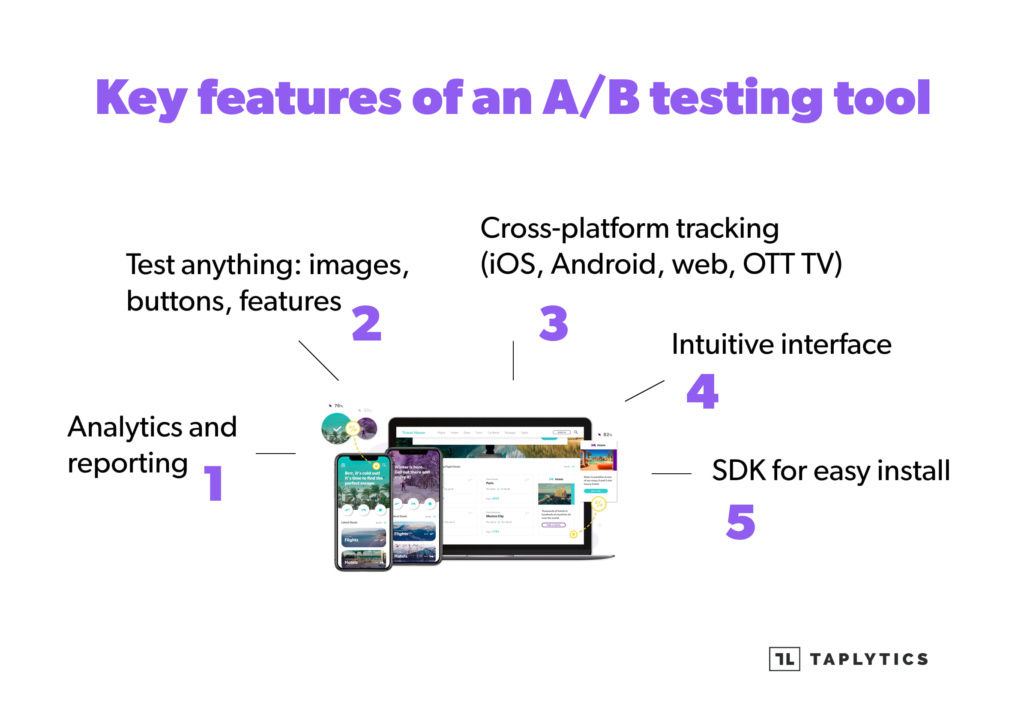Benefits to Utilizing A/B Testing Platforms

How do you know which A/B testing tool is right for you? It’s a tough question and this guide answers it thoroughly. It depends on factors like which platforms you need to test, how many tests you plan to run, and your goals. Some tools specialize in mobile. Others, web. A select few help drive revenue. This guide covers them all.
TLDR: Taplytics is a great all-around choice
What is an A/B testing tool?
An A/B testing tool is a software program that lets you run experiments to find out which features users like and don’t like. For example, do users prefer image A over image B? Or are they more likely to click a link or a button? Product and marketing teams use tests to increase their site or app’s usage, conversions, and ideally, revenue.
How to determine which is the best A/B testing tool for you
The easiest way to begin your search for an A/B testing software is to narrow your choices. Make a list of every tool you’re considering and cross off the ones that are missing must-have features. For example, if Roku is a core platform of yours, you can ignore any A/B testing platform that doesn’t support it. Often, you’ll be able to reduce a pool of 10-12 candidates to just 2-3.
What are your non-negotiables? Ask yourself:
- What platforms do I need to test today?
- What about in the future?
- Do I need to test conversions and revenue?
- How many tests will I run?
- What’s my primary industry?
Common testing platforms include iOS, Android, web, and OTT platforms like tvOS, Android TV, Fire TV, and Roku. If you need to run tests that track conversions and tie back to revenue, you’ll need a platform that integrates with your CRM or whatever system holds that data. If you plan to run a lot of tests, you’ll probably need a platform with an intuitive interface that allows for codeless testing—testing where you don’t need help from engineering because it doesn’t require code.
You’ll want to avoid tools that don’t cater to your industry. They’re less likely to have a pricing model that makes you happy, and they won’t be able to prove that they can accommodate your use case.
Once you’ve eliminated those A/B testing platforms that aren’t a fit, rank the remaining vendors based on how well their features meet your needs.
Features of an ideal A/B testing tool
The best experimentation software for most companies is a hub that covers most common use cases, with a strong API so you can plug point solutions into it. You can call this your core testing platform. It should include most of the following features:
It supports your platforms and programming languages
Does the platform accommodate your current and planned platforms? One tool that accommodates all your platforms will give you the best data quality. If everything is housed in one place, there’s less chance that discrepancies arise between systems, or that data gets stuck in silos.
Easy to install SDK (or no-install testing options)
The more work it is to set up the tool, the longer it’ll take and the more opportunities there are to make mistakes that’ll throw off reporting. Give preference to vendors that simplify the installation with an SDK.
Easy to use interface
The easier it is for non-technical team members to run tests, the more tests they can run and the more you can improve the product. Tools with unintuitive interfaces slow things and leave product and marketing teams reliant on IT.
Terms to look for: Code-Free Testing, Visual Editor, Visual Optimizer
Code-based testing
Even easy interfaces should still have an option for technical team members to run advanced tests. For example, e-commerce teams may need to use custom code to test big changes, like whether visitors buy more clothing when the online store displays two rather than three columns of products.
Bonus: Ask if there’s a code variable library. This lets developers save code-based experiments to run future tests quickly.
Flexible data export options
Do you have full control over your data? Any A/B testing tool should allow you to export raw testing data to a CSV file or other systems for analysis in other tools.
Breadth of integrations
Does it easily integrate with your existing tool stack? Look for lots of pre-built integrations to systems like Adobe, Google Analytics, Tableau, Amplitude, Looker, and more, plus a flexible API for the less common integrations.
Flexible reporting and event tracking
Can you customize the reports and define your own custom events? If not, it had better have a good integration to whatever analytics tool you plan to use.
Powerful segmentation
How deep does the segmentation go? Can you filter by multiple variables? Custom variables? Does the system support random bucketing, saved segments, and cohort tracking?
Server- or client-side testing options
Does the tool allow you to define whether tests are run server-side or client-side? Depending on your site or app, you may need both.
High number of simultaneous users or experiments
Does the tool support your desired number of users and experiments on the plan you’ve selected? Will your experimentation software remain affordable as you scale?
Flawless test delivery
Look for a system that runs imperceptible tests. When a tool is built poorly and is slow at delivering A/B tests, users sometimes see a flicker effect, which degrades their experience and either makes the app look like its malfunctioning or alerts users that they’re part of a test.
Mobile testing that doesn’t require an App Store update
The two big app stores require documentation and approvals for app updates that can slow teams down. Look for an A/B testing tool that allows mobile testing without App Store updates.
How to select a vendor for your core A/B testing platform
There are six factors to selecting a great vendor:
Experience
What’s the overall experience with the vendor? Have the employees you’ve met seemed knowledgeable and consultative? Ask for backdoor recommendations from colleagues and read online reviews at sites like G2 Crowd and TrustRadius. A great experience and a reliable, responsive partner can offset a lot of other downsides.
Data security and privacy options
Make sure your vendor protects your user data as carefully as you do. Established companies with higher-profile clients and stronger procedures for safeguarding your consumer data are a safer bet.
Reliability
Does the app have existing customers in your vertical? Vendors that do are more likely to have validated the tool for your use case, which can help you avoid unexpected development costs, support costs, and crashes in the event of a huge influx of new users.
Support
Does the tool have extensive and knowledgeable support staff? How much support time do you get with your plan? Support staff with previous experience in the industry can help you move faster with guidance on getting things set up properly the first time around.
Innovation
Is the vendor constantly patching bugs and adding new features? One of the greatest benefits to purchasing an A/B testing software is that they have an entire product team dedicated to making it better. Ask to see the company’s recent product updates.
Cost
Consider the total cost of ownership. Add together all implementation, support, and upkeep fees before comparing two vendors. Often, cheaper options grow more expensive when you factor in the time it takes your IT team to make ill-fitting tools work.
Best tools for A/B and multivariate testing
Have your criteria ready? Here’s a list of some of the top tools for A/B testing:
- Taplytics: A platform for mobile A/B testing, analytics, and optimization
- mParticle: A single platform for collecting and storing user data
- Amplitude: In-app analytics and event tracking
- Google BigQuery: Analytics data warehouse
- Instabug: In-app feedback collection and bug reporting
- Appsee: User recordings and heatmaps
- Looker: BI data visualization and analysis

